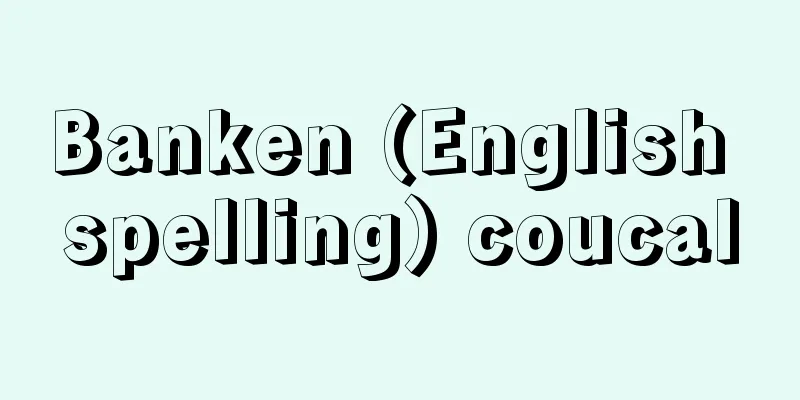Air gun - Air gun

|
A gun that uses air pressure to fire a metallic bullet. It is also called an air gun. Guns that shoot with a cork stuffed into the muzzle are considered toys and are not included in the category of air guns. [Kunihiko Shirai] historyThe idea of firing bullets with air pressure has been around for a long time, as bellows and compression pumps were put to practical use before the Common Era, but the prototype of the modern air gun was a gun made by Guther in Nuremberg, Germany, in 1430. This was invented to replace the powder guns of the time, which had trouble firing in rain, fog, and strong winds, and took too long to fire the second shot. This gun was a pump-type gun, with a metal ball filled with air attached to the bottom of the gun and a structure that fired bullets using the force of the compressed air. It was adopted by the Austrian army during the Napoleonic era, and there are records of infantry battalions equipped with this gun firing against Napoleon's army. It was first introduced to Japan around 1640 (Kan'ei 17), as a gun of the same type as the one mentioned above, called a Windlul (wind gun), which was presented to the Shogun's family by the Netherlands. Later, using this gun as a model, Tobei Kunitomo of Goshu (Shiga Prefecture) produced a more powerful gun in March 1818 (Bunsei 1), which he named "kiho." Spring-loaded air guns then came to prominence, and were imported to Japan in the early Meiji period. Air guns have the disadvantage of not being able to produce the same amount of force as powder guns, but because they make almost no noise when fired, they have been used as covert weapons, and because they are inexpensive to make and the bullets are also cheap, they have become popular as sports firearms. Guns that contain a cylinder of liquefied carbon dioxide and fire using vaporized gas are also a type of air gun, but these are specifically called gas guns. [Kunihiko Shirai] Type and structureBased on their structure, air guns can be broadly classified into (1) spring-operated ((a) break, (b) lever) and (2) pump-operated. (1) is a gun that fires by compressing an internal spiral spring with arm strength, loading a bullet, and pulling the trigger, and uses either (a) or (b) to compress the spring. (a) is a gun that compresses the spring by folding the boundary between the barrel and the mechanism and returning it to its original position, and (b) is compressed by opening and closing a large lever attached to the bottom or side of the barrel. (2) is a gun with a compressed air storage chamber and a pump built into the gun itself that compresses and stores air in advance, and when the trigger is pulled, the exhaust valve opens and the compressed air fires a bullet. The advantage of the spring-type is that a sturdy gun can be made relatively cheaply, while the disadvantages are that the spring weakens easily, the barrel and the mechanism are not separate, so air that is ejected from the air chamber into the gun cavity is prone to leaking, the piston collides with the wall of the air chamber, causing vibrations that can impair the aim, and it is heavy because it has many iron parts. The advantages of the pump-type are that there is less recoil when fired and that the elasticity can be adjusted by the number of times the pump is operated, while the disadvantages are that it is expensive to manufacture, has low durability, and is prone to malfunctions. Important factors in an air gun with a high accuracy rate are a precisely manufactured barrel, a superior trigger mechanism with no uneven pull, precise sights, and good balance. The bullets are made of lead or an alloy of lead and antimony, and come in drum, triangular, and spherical shapes. There are 12 calibers ranging from 4 to 6.5 mm, but 5.5 mm (22 diameter), 5 mm (20 diameter), and 4.5 mm (17.7 diameter) are the most common. Of these, 4.5 mm is the most common. The larger the caliber, the more lethal it is. Some guns can shoot shotgun pellets, but they are very weak due to insufficient air pressure. There are also tranquilizer guns that shoot nicotinic acid in a syringe and inject it into animals at a distance (within 50 meters) to tranquilize them. Although this is based on the same principle as an air gun, the bullets are completely different, so it is generally considered to be a separate gun. There are air guns for shooting competitions and for hunting, the former of which are designed with an emphasis on accuracy and are equipped with various accessories including precise aiming devices, while the latter are designed with an emphasis on flexibility and lightness. In order to possess an air rifle, a license from the Public Safety Commission is required, and in order to hunt birds and animals with an air rifle, a "Class C hunting license" and "Class C hunter registration" with the prefecture are required. For information on shooting competitions using air guns, see the "Rifle Shooting" section. [Kunihiko Shirai] [References] | |©Shogakukan "> Air gun structure Source: Shogakukan Encyclopedia Nipponica About Encyclopedia Nipponica Information | Legend |
|
空気の圧力を利用して、金属性の弾丸を発射する銃。エアガンともいう。銃口にコルクを詰めて撃つ銃は玩具(がんぐ)とみなされ、空気銃の範疇(はんちゅう)には入れられていない。 [白井邦彦] 歴史空気圧で弾丸を発射する考えは、ふいごや圧縮ポンプの装置が紀元前から実用化されていたため、古くからあったが、近代の空気銃の母型は1430年にドイツのニュルンベルクのグーテルの製作した銃である。これは、当時の装薬銃が、雨、霧、強風の日などにトラブルがあるのと、次発(2発目の発射)に時間がかかりすぎるため、これにかわるべく発明されたものである。その銃はポンプ式で、あらかじめ空気を圧入した金属球が銃の下部に取り付けられ、圧縮空気の噴出力で弾丸を発射する構造になっており、ナポレオン時代にオーストリア軍が採用し、これを装備した歩兵大隊がナポレオン軍に撃ち向かった記録がある。日本に初めて紹介されたのは1640年(寛永17)ごろで、オランダから将軍家に献上されたウィンドルウル(風炮(ふうほう))という前記のものと同形式の銃である。のちこの銃を手本にして、江州(ごうしゅう)(滋賀県)の国友藤兵衛が1818年(文政1)3月に、より高性能のものを製作して気砲と名づけた。その後スプリング式の空気銃が台頭し、明治初期に日本に輸入された。 空気銃は装薬銃ほどの弾力が得られない欠点があるが、ほとんど発射音がないため隠密武器にされることがあったほか、安価につくれ弾丸も低廉なので、スポーツ用銃器として普及の道をたどった。なお、液化炭酸ガスのボンベを内蔵し、気化ガスによって発射する銃も空気銃の一種であるが、とくにガス銃という。 [白井邦彦] 種類・構造空気銃は構造上、(1)スプリング式((a)中折、(b)レバー)と(2)ポンプ式に大別される。 (1)は内装された螺旋(らせん)形のスプリングを腕力で圧縮し、弾丸を込めて引き金を引くことにより発射する構造で、スプリングを圧縮するのに(a)(b)いずれかの方式によっている。(a)は銃身部と機関部の境界部を折り曲げて元に戻すと、スプリングが圧縮されて撃発が可能になる構造で、(b)は銃身の下部または側方についている大きなレバーを開閉して圧縮する。 (2)は銃に圧縮空気の貯蔵室が備えられ、銃自体に作り付けられたポンプで、あらかじめ空気を圧縮貯蔵しておき、引き金を引くと排気弁が開かれ、圧縮空気で弾丸が発射される構造である。スプリング式の長所は、堅牢(けんろう)な銃を比較的安価につくれること、短所は、スプリングが弱まりやすい点、銃身部と機関部が遊離していないため、気室から銃腔(じゅうこう)に噴出される空気が漏れやすい点、ピストンが気室の壁に激突するので、そのとき振動を生じてねらいが損なわれる点、鉄の部分が多いため重い点などである。ポンプ式の長所は、発射時の反動が少ない点と、ポンプ操作の回数で弾力を加減できる点で、短所は製作コストが高い点、耐久性が低く故障が多い点などである。 命中率の高い空気銃は、銃腔が精密につくられていること、引き金機構が優れていて引きむらのないこと、照準具が精密であること、バランスのよいことなどの要素がたいせつである。 弾丸は鉛または鉛とアンチモンの合金でつくられ、鼓形、三角形、球状などがあり、口径は4ミリから6.5ミリまで12種あるが、5.5ミリ(22径)、5ミリ(20径)、4.5ミリ(17.7径)が普通である。なかでも4.5ミリがもっとも普及している。口径が大きいほど殺傷力が大きいということはない。散弾を射出できるものもあるが、空気圧が不足のため威力は甚だしく弱い。また、注射筒に入ったニコチン酸を発射して、遠方(50メートル以内)の動物に注射し、麻酔させる麻酔銃もあるが、これは原理は空気銃ながら、弾丸がまったく異なるので、一般に独立した銃とされている。空気銃には射撃競技用のものと狩猟用のものがあり、前者は命中精度に重点が置かれ、精密な照準具をはじめ種々の付属装置がつけられており、後者は弾力と軽快さを重点に製造されている。 空気銃を所持するには公安委員会の所持許可が必要であり、空気銃で鳥獣をとろうとするには、「丙種狩猟免状」と都道府県の「丙種狩猟者登録」をすることと定められている。 なお、空気銃による射撃競技については、「ライフル射撃」の項を参照。 [白井邦彦] [参照項目] | |©Shogakukan"> 空気銃の構造 出典 小学館 日本大百科全書(ニッポニカ)日本大百科全書(ニッポニカ)について 情報 | 凡例 |
<<: Air purifier - kuukiseijouki
Recommend
Decalogue; Ten Commandments
The Ten Commandments of Moses. The original meanin...
Bjørnstjerne Bjørnson
Norwegian playwright, novelist, and poet. Born in...
Anthicidae
…A general term for insects belonging to the fami...
Jōkyūki - Jōkyūki
A military chronicle about the Jōkyū War. It was ...
Faysal I (English spelling)
In 1824, Muhammad ibn Saud's grandson Turki (...
Placentation
…The location of the placenta in the ovary varies...
Contumax kobelti (English) Contumax kobelti
...Because they are abundant, they are used as ma...
Kanoko Okamoto - Kanoko Okamoto
Novelist and poet. Born in Tokyo on March 1, 1889...
"Modern Literature Notes"
…He was active in editing the Complete Works of T...
Kineya Shojiro (first generation)
…First performed at the Edo Kawarazaki Theater in...
Callicarpa mollis
…[Murata Gen]. … *Some of the terminology that me...
Floating servants
...A type of miscellaneous tax in the Edo period....
Tripitaka Master Cimin (English: Tripitaka Master Cimin)
680‐748 A monk from the Tang Dynasty in China, and...
Thymocytes
Also called thymic lymphocytes. These cells are de...
American wind grass - American wind grass
...The inflorescence of E. japonica Thunb. is sle...









